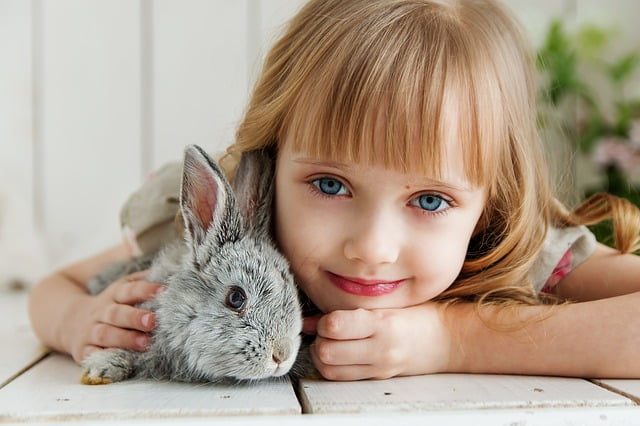Caring for your Rabbit
 Photo: nastya_gepp, Pixabay
Photo: nastya_gepp, PixabayIn the UK, the rabbit is the third most popular pet and, like the dog and cat, make a rewarding companion.
Here are a few tips on how to keep your rabbit healthy and happy:
Companionship
Rabbits are social animals so where ever possible keep them with at least one other rabbit. A good combination is a neutered male and neutered female. It is common to see rabbits housed with a Guinea Pig, although it is far better to mix the same species together. Sometimes rabbits can bully Guinea Pigs and this can cause serious welfare implications for them.
Litter mates, once neutered, often mix well. However it is possible to mix rabbits from different litters. Introductions must be carefully managed. Click here for tips on how to safely introduce rabbits to one another
Unfortunately many rabbits are housed alone which means they rely upon human company which may not always be forthcoming, especially during the winter months. Try and spend some regular time interacting with them to help relieve boredom. Provide them with an enriched environment and consider clicker training them to help to keep them mentally stimulated.
In the UK, the rabbit is the third most popular pet and, like the dog and cat, make a rewarding companion.
Housing
Sadly many rabbits are kept solely in traditional small hutches. These do not meet the rabbits’ needs as they are often cramped, have poor ventilation and do not provide them with the opportunity to exercise and behave normally.
Rabbits should spend at least 4 hours a day exercising and moving around exploring their surroundings. Skeletal problems and obesity often develop due to inactivity so as well as a secure main shelter, give them a secure run with opportunities to hop, run, jump and dig as well as eat grass.
For out-door rabbits, remember that in extremes of weather you should make provision for them. It is common for vets to see rabbits in the surgery with hypothermia (a serious drop in body temperature) in the winter months. Think about placing their hutch in a sheltered spot with lots of hay for added insulation and make sure it is sited away from driving winds and rain.
Diet
The rabbit should be fed predominantly a diet of hay (at least 70 to 80% of the total diet) and feeding fresh growing grass as lib is also beneficial. These are naturally low in sugar and high in fibre which is essential for a healthy digestive system and dental wear.
All too often vets see serious dental problems due to them being fed an inappropriate diet. A small amount of a high quality commercial rabbit food is also recommended as they are supplemented with vitamins and minerals. Excessive feeding of commercial diets can however lead to obesity. Avoid muesli type diets and instead choose a brand that is in a complete pellet or nugget form.
BURGESS Pet Care Products: https://www.burgesspetcare.com/products/rabbit/. Feeding these types of diet stops the rabbit from selecting only their favourite pieces which are usually high calorie items and low in fibre.
Just feeding a commercial diet means that the rabbit spends less time foraging and this can lead to boredom.
A small handful of leafy and fibrous vegetables in moderation can be scattered in the run daily e.g. spinach, cabbage, broccoli, carrot tops (in moderation) lettuce (in moderation avoiding Iceberg) and watercress. Fresh drinking water should always be available.
Scatter feeding can help relieve boredom but it is important to provide other mental and physical stimulation too.
Providing an Enriched Environment
The behaviourally sterile environment provided in most cages and runs can be enriched quite easily by providing pipes for them to sit/stand on, suspended items of food and hay in hayracks, adding logs that are safe for them to gnaw on (e.g. hazel/apple trees) or adding a cardboard box or two for them to investigate.
Other simple and cheap ideas include:
- Shredded brown paper can be put in a pile with some food hidden in amongst it
- Cardboard boxes with two or more holes cut in them to allow them to move in and out of. Stuffing them with a pile of shredded paper and a hidden healthy treat inside adds interest
- Digging opportunities are a good idea. A sand-pit with child-friendly sand or a bag of soil can be a safe place for them to have fun
- Chin secretions, urine and droppings are used to communicate through scent. So provide objects like a small pile of safe logs to enable a rabbit to exhibit these normal behaviours
- Rabbit friendly toys for chewing and investigating are available to purchase
- Try clicker training your rabbit –getting a recall has a practical benefit as well as providing them with some mental stimulation.